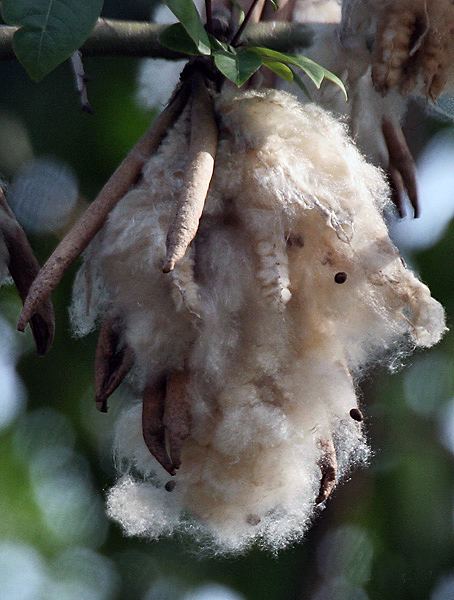 | ||
Fiber or fibre (from the Latin fibra) is a natural or synthetic substance that is significantly longer than it is wide. Fibers are often used in the manufacture of other materials. The strongest engineering materials often incorporate fibers, for example carbon fiber and ultra-high-molecular-weight polyethylene.
Contents
- Natural fibers
- Man made fibers
- Semi synthetic fibers
- Cellulose regenerated fibers
- Synthetic fibers
- Metallic fibers
- Carbon fiber
- Silicon carbide fiber
- Fiberglass
- Mineral fibers
- Polymer fibers
- Microfibers
- References
Synthetic fibers can often be produced very cheaply and in large amounts compared to natural fibers, but for clothing natural fibers can give some benefits, such as comfort, over their synthetic counterparts.
Natural fibers
Natural fibers develop or occur in the fiber shape, and include those produced by plants, animals, and geological processes. They can be classified according to their origin:
Man-made fibers
Man-made or chemical fibers are fibers whose chemical composition, structure, and properties are significantly modified during the manufacturing process. Man-made fibers consist of regenerated fibers and synthetic fibers.
Semi-synthetic fibers
Semi-synthetic fibers are made from raw materials with naturally long-chain polymer structure and are only modified and partially degraded by chemical processes, in contrast to completely synthetic fibers such as nylon (polyamide) or dacron (polyester), which the chemist synthesizes from low-molecular weight compounds by polymerization (chain-building) reactions. The earliest semi-synthetic fiber is the cellulose regenerated fiber, rayon. Most semi-synthetic fibers are cellulose regenerated fibers.
Cellulose regenerated fibers
Cellulose fibers are a subset of man-made fibers, regenerated from natural cellulose. The cellulose comes from various sources: rayon from tree wood fiber, Modal from beech trees, bamboo fiber from bamboo, seacell from seaweed, etc. In the production of these fibers, the cellulose is reduced to a fairly pure form as a viscous mass and formed into fibers by extrusion through spinnerets. Therefore, the manufacturing process leaves few characteristics distinctive of the natural source material in the finished products.
Some examples are:
Historically, cellulose diacetate and -triacetate were classified under the term rayon, but are now considered distinct materials.
Synthetic fibers
Synthetic come entirely from synthetic materials such as petrochemicals, unlike those man-made fibers derived from such natural substances as cellulose or protein.
Fiber classification in reinforced plastics falls into two classes: (i) short fibers, also known as discontinuous fibers, with a general aspect ratio (defined as the ratio of fiber length to diameter) between 20 and 60, and (ii) long fibers, also known as continuous fibers, the general aspect ratio is between 200 and 500.
Metallic fibers
Metallic fibers can be drawn from ductile metals such as copper, gold or silver and extruded or deposited from more brittle ones, such as nickel, aluminum or iron. See also Stainless steel fibers.
Carbon fiber
Carbon fibers are often based on oxydized and via pyrolysis carbonized polymers like PAN, but the end product is almost pure carbon.
Silicon carbide fiber
Silicon carbide fibers, where the basic polymers are not hydrocarbons but polymers, where about 50% of the carbon atoms are replaced by silicon atoms, so-called poly-carbo-silanes. The pyrolysis yields an amorphous silicon carbide, including mostly other elements like oxygen, titanium, or aluminium, but with mechanical properties very similar to those of carbon fibers.
Fiberglass
Fiberglass, made from specific glass, and optical fiber, made from purified natural quartz, are also man-made fibers that come from natural raw materials, silica fiber, made from sodium silicate (water glass) and basalt fiber made from melted basalt.
Mineral fibers
Mineral fibers can be particularly strong because they are formed with a low number of surface defects, asbestos is a common one.
Polymer fibers
Microfibers
Microfibers in textiles refer to sub-denier fiber (such as polyester drawn to 0.5 denier). Denier and Dtex are two measurements of fiber yield based on weight and length. If the fiber density is known, you also have a fiber diameter, otherwise it is simpler to measure diameters in micrometers. Microfibers in technical fibers refer to ultra fine fibers (glass or meltblown thermoplastics) often used in filtration. Newer fiber designs include extruding fiber that splits into multiple finer fibers. Most synthetic fibers are round in cross-section, but special designs can be hollow, oval, star-shaped or trilobal. The latter design provides more optically reflective properties. Synthetic textile fibers are often crimped to provide bulk in a woven, non woven or knitted structure. Fiber surfaces can also be dull or bright. Dull surfaces reflect more light while bright tends to transmit light and make the fiber more transparent.
Very short and/or irregular fibers have been called fibrils. Natural cellulose, such as cotton or bleached kraft, show smaller fibrils jutting out and away from the main fiber structure.
